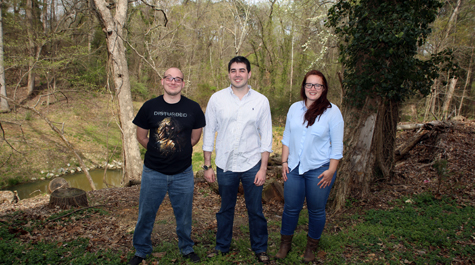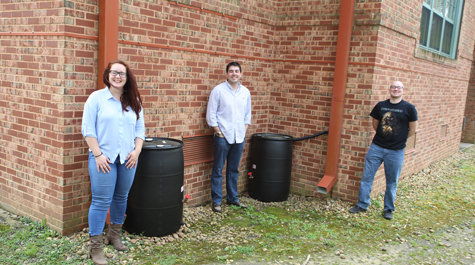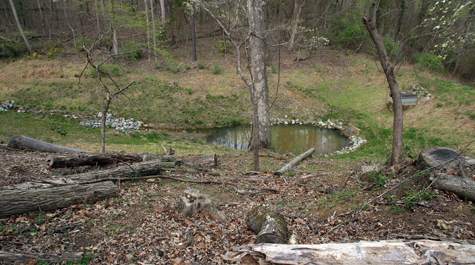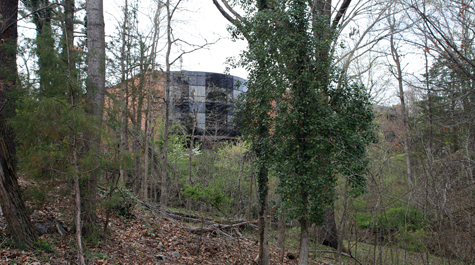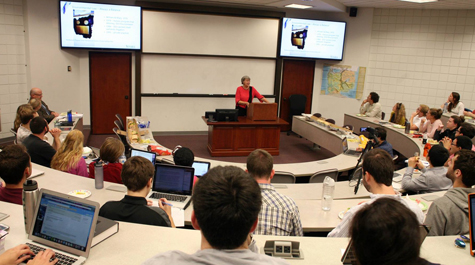SEALS Students Have an Impact on Sustainability at William & Mary
Think of lawyers and green fees and the idea of jurists spending a leisurely afternoon on a golf course comes to mind.
But for the Student Environmental and Animal Law Society (SEALS), a green fee represents a vital amount of money that allows law students at William & Mary to have a significant impact on the College's sustainability--and on their own educational experiences.
Last fall, Emily Gabor J.D. ’17, co-president of the Student Environmental and Animal Law Society (SEALS), received a Green Fee Award of $1,876 from the William & Mary Committee on Sustainability. The funding allowed SEALS to install rain barrels at the Gradplex next to the Law School.
“The idea is to capture rain water so less of it goes into the detention pond behind the Law School,” Gabor says. “All the runoff from the Law School, parking lot, and Gradplex goes straight into the pond because the mostly paved ground doesn’t soak in the water like it’s supposed to.”
The project meshes perfectly with the work of the College’s Facilities Management team, which oversees a detailed storm water management system and a storm water management plan to protect the waterways and, ultimately, the Chesapeake Bay.
“A lot of the features in the system, called Best Management Practices, are hidden away and not part of the landscape that gets enjoyed,” says Van Dobson, Associate Vice President of Facilities Management. “But they need to be sustained over time, so they can protect the Bay and the Virginia waterways.”
With SEALS taking care of the rain barrels, Facilities Management will work on stabilizing the structure of the detention pond.
“Stabilizing the banks is the first step in a comprehensive plan to improve the detention pond,” Gabor says. “The second part of the project involves removing invasive species with shallow, widespread roots that don’t really capture rain water the way native plants would. We’re going to try planting some grasses and shrubs that are more apt for the environment.”
This is not the first time SEALS has worked toward campus sustainability improvements. Last year the group put in a green fee proposal to improve, clean up, and more carefully mark the heavily trafficked, thickly wooded trails around William & Mary’s celebrated Lake Matoaka, the oldest man-made lake in Virginia and one of the oldest in the United States. The project has proven to have a significant impact on the safety and the recreational experience of users and on the environment.
“Any time student groups can help with sustainment and improvement of William & Mary’s campus, it’s a very positive thing for those doing the work and for those who get to enjoy the benefits of their effort,” Dobson says.
Gabor, who hails from Milwaukee, said that SEALS is a natural fit for students like her who enjoy the outdoors, especially hiking and field trips. She is also grateful that the Law School strongly supports environmental law, and fosters working partnerships with other groups, including the Law School’s Virginia Coastal Policy Center.
“SEALS does a lot with the Coastal Policy Center,” Gabor says. “We partner with them to bring in guest speakers, go on field trips, and plan events around town. We do an Arbor Day event in Newport News, and get lots of support from them in terms of equipment and funding and helping with advertising.”
Students also praise the work of Law School faculty for their knowledge of environmental law and unstinting support.
“Our professors are incredible helpful,” Gabor says. “Professor Lynda Butler is our advisor, and Professor [Linda] Malone and Professor [Ron] Rosenberg offer great advice. There are lots of people and resources here to get things done.”
Gabor considers the Green Fee projects the most rewarding part of her work with environmental issues.
“The fact that the School has been so cooperative has made it really easy to have an impact on campus,” she says. “Even in the short time I’ve been with SEALS, I’ve seen the new kiosks with trail guides and maps around Lake Matoaka. We’ve received some nice community feedback on that.”
Calandra Waters Lake, William & Mary’s Director of Sustainability, says that the success of Green Fee projects is a highlight of her job.
“The SEALS project is the perfect example of a motivated and organized group of students that have collaborated with faculty and staff to enact change on the William & Mary campus,” Lake says. “Their project has shown clear vision and planning, and characterizes sustainability in addressing not just storm water impacts but also striving to create an area that students can enjoy in the future.”
If the project proves successful, SEALS hopes to add more rain barrels behind the Law School building itself. Dan Thompson J.D. ’18, the incumbent vice president of SEALS, says he plans to build on that work after Gabor graduates. He also hopes to install more water bottle refilling stations in the Law School.
“There’s always a large line at the bottle filling station in the North Wing of the Law School,” Thompson says. “If we can get another station along the lecture halls and in the library, it will speed things up for students getting ready for class.”
The Green Fee program began as a grassroots student initiative in 2008 when students throughout the College overwhelmingly voted to impose a green fee on themselves. It has funded hundreds of sustainability projects led by students, faculty and staff around the William & Mary campuses. This semester saw a wide variety of proposals, from campus-wide initiatives to innovative sustainability research projects. A total of $68,333 was dedicated to sustainability projects around campus.
“Students are doing things they believe in, and they’re typically energetic,” says Van Dobson. “I personally think of it as a very positive experience because of the energy they bring, and the new way of looking at problems we face--solutions that couldn’t have been afforded or just not thought of.”
SEALS mission is to: increase awareness and involvement in environmental and animal law issues; promote and contribute to careers, service, and scholarship in environmental and animal law; encourage stewardship in public policy, jurisprudence, and law; provide opportunities for environmental and animal rights advocacy; and improve environmental policies at the College of William & Mary.
About William & Mary Law School
Thomas Jefferson founded William & Mary Law School in 1779 to train leaders for the new nation. Now in its third century, America's oldest law school continues its historic mission of educating citizen lawyers who are prepared both to lead and to serve.
